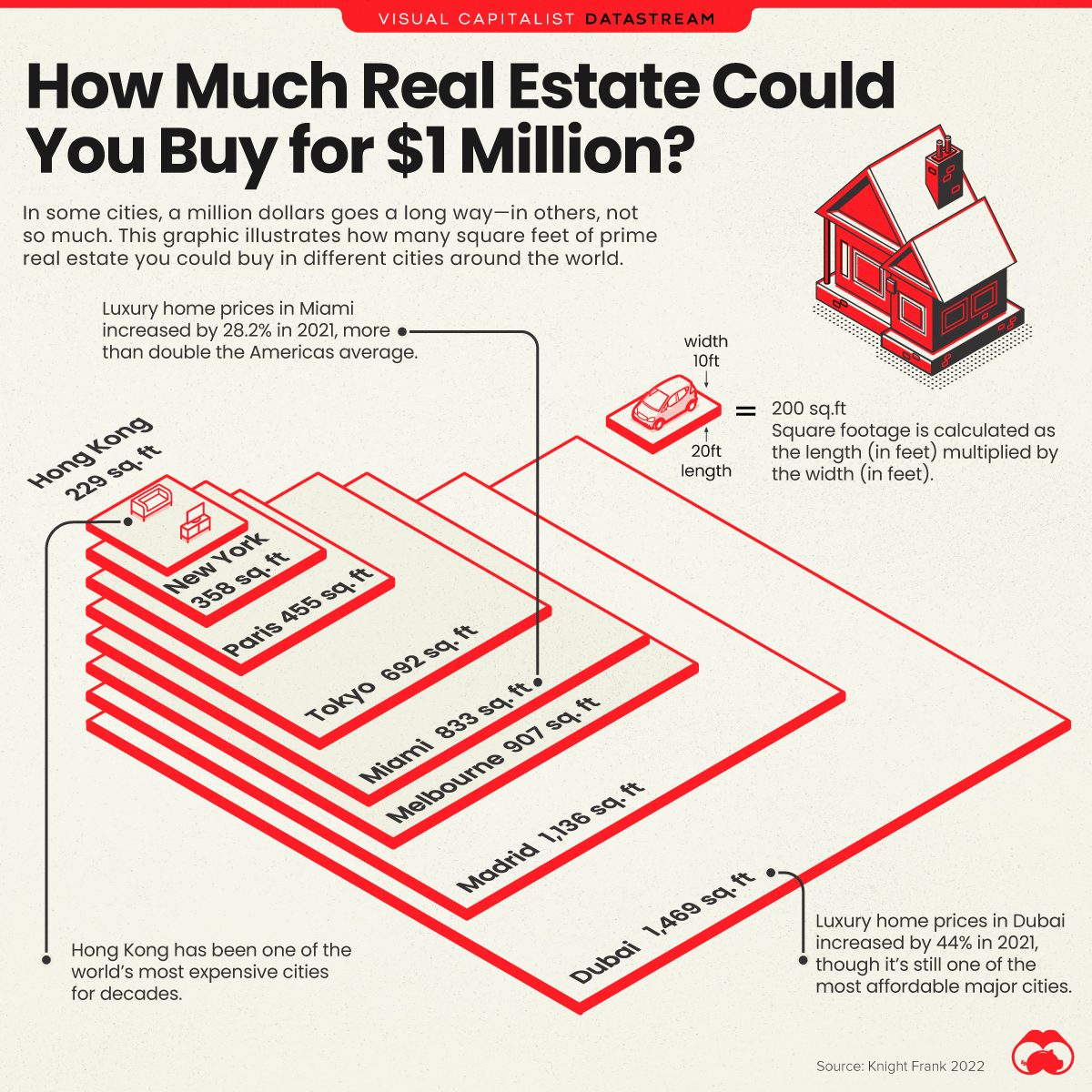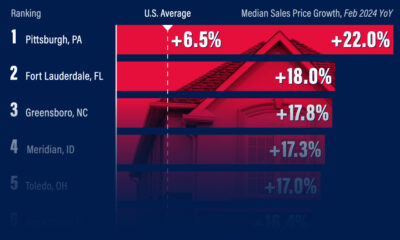Datastream
How Much Prime Real Estate Could You Buy for $1 Million?

The Briefing
- Housing affordability can vary significantly from city to city
- $1 million USD can buy over 6 times more space in Dubai than in Hong Kong
How Much Real Estate Could You Buy for $1 Million?
“There are three things that matter in property: location, location, location”
Those are words from Harold Samuel, a British real-estate mogul from the 1900s. Broadly speaking, it’s a quote that still holds true—property values in the world’s best cities have always been worth a pretty penny.
The scarcity of real estate is driven by trends such as urbanization, which is the migration of people into cities. While the first examples of cities were built thousands of years ago, it was only recently that the majority of the population began to live in them. In fact, the urban population just overtook the rural population for the first time in 2007.
Of course, certain cities simply hold more appeal for wealthy people, and as a result, competition in the prime real estate market can be fierce.
To learn more about the sky-high cost of prime property in cities, this infographic visualizes data from Knight Frank’s Prime International Residential Index (PIRI 100).
What’s a Million Dollars Good For?
The following table lists the number of square feet that you could buy with one million dollars in various cities. We’ve included more cities on this list than in the graphic to create a more comprehensive comparison.
| City | Country | Square feet of prime property for $1 million (USD) |
|---|---|---|
| Monaco | 🇲🇨 Monaco | 157 |
| Hong Kong | 🇨🇳 China | 229 |
| London | 🇬🇧 United Kingdom | 329 |
| New York | 🇺🇸 United States | 358 |
| Singapore | 🇸🇬 Singapore | 381 |
| Geneva | 🇨🇭 Switzerland | 399 |
| Sydney | 🇦🇺 Australia | 446 |
| Shanghai | 🇨🇳 China | 452 |
| Los Angeles | 🇺🇸 United States | 454 |
| Paris | 🇫🇷 France | 455 |
| Beijing | 🇨🇳 China | 601 |
| Tokyo | 🇯🇵 Japan | 692 |
| Berlin | 🇩🇪 Germany | 786 |
| Miami | 🇺🇸 United States | 833 |
| Melbourne | 🇦🇺 Australia | 907 |
| Madrid | 🇪🇸 Spain | 1,136 |
| Mumbai | 🇮🇳 India | 1,164 |
| Dubai | 🇦🇪 UAE | 1,469 |
| Cape Town | 🇿🇦 South Africa | 2,363 |
| São Paulo | 🇧🇷 Brazil | 2,759 |
Monaco, the most expensive city on this list, is incredibly land-constrained with an area of just 0.78 square miles. For context, New York’s Central Park is 1.31 square miles in size.
In second place is Hong Kong, which has become notorious for its difficult real estate market. Just 7% of the city is zoned for residential use, which pushes many of its citizens into sub-100 square feet micro apartments. These housing units offer grim living standards and are often referred to as “coffin homes”.
On the other side of the spectrum, Hong Kong recently set the record for the most expensive home in Asia. A 3,378 square foot penthouse sold for $59 million in 2021, translating to $17,500 per square foot.
What is Prime Real Estate?
You may be wondering what prime real estate is.
Knight Frank defines it as “the most desirable and expensive property in the area, generally defined as the top 5% of the market by value.” This suggests that the prices visualized above are on the upper end of the scale, and that more attainable homes are available.
» If you’re interested in urbanization, consider this infographic which ranks the 20 largest cities in the world.
Where does this data come from?
Source: The Knight Frank Prime International Residential Index (PIRI 100)
Datastream
Can You Calculate Your Daily Carbon Footprint?
Discover how the average person’s carbon footprint impacts the environment and learn how carbon credits can offset your carbon footprint.

The Briefing
- A person’s carbon footprint is substantial, with activities such as food consumption creating as much as 4,500 g of CO₂ emissions daily.
- By purchasing carbon credits from Carbon Streaming Corporation, you can offset your own emissions and fund positive climate action.
Your Everyday Carbon Footprint
While many large businesses and countries have committed to net-zero goals, it is essential to acknowledge that your everyday activities also contribute to global emissions.
In this graphic, sponsored by Carbon Streaming Corporation, we will explore how the choices we make and the products we use have a profound impact on our carbon footprint.
Carbon Emissions by Activity
Here are some of the daily activities and products of the average person and their carbon footprint, according to Clever Carbon.
| Household Activities & Products | CO2 Emissions (g) |
|---|---|
| 💡 Standard Light Bulb (100 watts, four hours) | 172 g |
| 📱 Mobile Phone Use (195 minutes per day)* | 189 g |
| 👕 Washing Machine (0.63 kWh) | 275 g |
| 🔥 Electric Oven (1.56 kWh) | 675 g |
| ♨️ Tumble Dryer (2.5 kWh) | 1,000 g |
| 🧻 Toilet Roll (2 ply) | 1,300 g |
| 🚿 Hot Shower (10 mins) | 2,000 g |
| 🚙 Daily Commute (one hour, by car) | 3,360 g |
| 🍽️ Average Daily Food Consumption (three meals of 600 calories) | 4,500 g |
| *Phone use based on yearly use of 69kg per the source, Reboxed | |
Your choice of transportation plays a crucial role in determining your carbon footprint. For instance, a 15 km daily commute to work on public transport generates an average of 1,464 g of CO₂ emissions. Compared to 3,360 g—twice the volume for a journey the same length by car.
By opting for more sustainable modes of transport, such as cycling, walking, or public transportation, you can significantly reduce your carbon footprint.
Addressing Your Carbon Footprint
One way to compensate for your emissions is by purchasing high-quality carbon credits.
Carbon credits are used to help fund projects that avoid, reduce or remove CO₂ emissions. This includes nature-based solutions such as reforestation and improved forest management, or technology-based solutions such as the production of biochar and carbon capture and storage (CCS).
While carbon credits offer a potential solution for individuals to help reduce global emissions, public awareness remains a significant challenge. A BCG-Patch survey revealed that only 34% of U.S. consumers are familiar with carbon credits, and only 3% have purchased them in the past.
About Carbon Streaming
By financing the creation or expansion of carbon projects, Carbon Streaming Corporation secures the rights to future carbon credits generated by these sustainable projects. You can then purchase these carbon credits to help fund climate solutions around the world and compensate for your own emissions.
Ready to get involved?
>> Learn more about purchasing carbon credits at Carbon Streaming
-

 Markets1 week ago
Markets1 week agoU.S. Debt Interest Payments Reach $1 Trillion
-

 Markets2 weeks ago
Markets2 weeks agoRanked: The Most Valuable Housing Markets in America
-

 Money2 weeks ago
Money2 weeks agoWhich States Have the Highest Minimum Wage in America?
-

 AI2 weeks ago
AI2 weeks agoRanked: Semiconductor Companies by Industry Revenue Share
-

 Markets2 weeks ago
Markets2 weeks agoRanked: The World’s Top Flight Routes, by Revenue
-

 Countries2 weeks ago
Countries2 weeks agoPopulation Projections: The World’s 6 Largest Countries in 2075
-

 Markets2 weeks ago
Markets2 weeks agoThe Top 10 States by Real GDP Growth in 2023
-

 Money2 weeks ago
Money2 weeks agoThe Smallest Gender Wage Gaps in OECD Countries
















